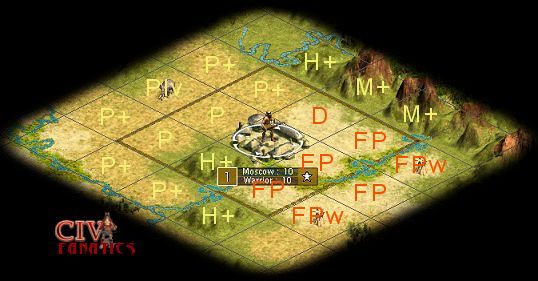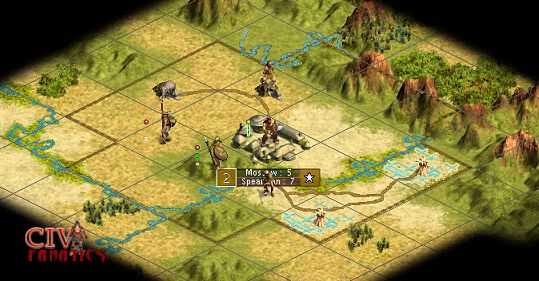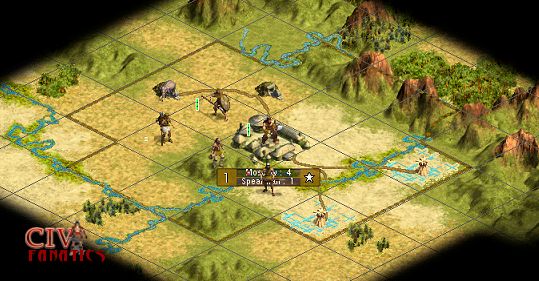 Flood Plain Balanced Rush
Opening
Flood Plain Balanced Rush
Opening
|
Quick Start Challenge Items below this point
Known Bugs and Glitches |
Again if you would like to try your own skills at this developing this start position you may download the exact map that was used for GOTM8 with all the civilizations and barbarians located in the same opening positions. Click here for the instructions to download the GOTM8 start positions replay scenario.
Balancing food and shields production but emphasize food and pop rushing
This is a test of using a hybrid approach that provides some initial balanced shield production but then pushes the food production to as high a level as reasonably possible and uses pop rushing sparingly. Our task sequence will mine the plains square next to a river immediately north of Moscow and then hook up only the road to the ivory. We will then race back across the river to irrigate and road the wheat bonuses on the flood plains. Here is a timeline of this sequence of events to help visualize the primary approach plus a slight alternate sequence:
To develop this example,
I played the sequence through about seven or eight different times with a
number of minor changes in unit movements for each turn. In any case other
than pop rushing in year 2310 BC, a citizen dies in
The units produced in this sequence included at least one warrior, two settlers, and two spearmen. The third settler shown in the timeline table above represents the high end of the variability that gets introduced into this opening location by the presence of the random number generation associated with the flood plain disease effects. In many cases, this position would produce fewer units than this idealized example.
Summary Again we were able to substantially improve on the performance of the AI player program by emphasizing shield production to provide some balance to the massive food production capacity of the flood plains and wheat bonus squares. We could also make selective use of the ability to hurry units under despotism by selectively converting some citizens into production output on a rushed basis. Rushed output in this example does produce some overlap with the normal production of shields so this can cause a few more shields to be wasted or duplicated in the big picture.
Because the flood plain disease issue can play such a pivotal role in the success of our start position, we can explore one final set of opening move sequences to examine the case where we might have a justifiable set of reasons for moving the settler from the original start position. It is important to emphasize that it is in your best interest to not waste a game turn by moving the initial settler unless there is a major set of reasons where this would benefit your game play strategy. Next example – Considering the choice to move the first settler
Other related topics:
|
|||||||||||||||||||||||||||||||||||||||||||||||||||||||||||||||||||||||||||||||||||||||||||||||||||||||||||||||||||||||||||||||||||||||||||||||||||||||||||||||||||||||||||||||||||||||||||||||||||||||||||||||||||||||||||||||||||||||||
 ©
2002 by cracker@CivFanatics.com
©
2002 by cracker@CivFanatics.com
All rights reserved. Please read the Terms
of Use.
Send mail to our webmaster with technical
questions about or potential problems with this web site.
 -
-  -
- 




